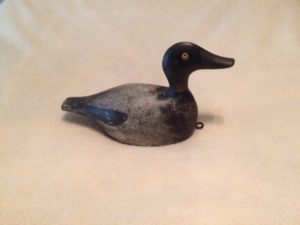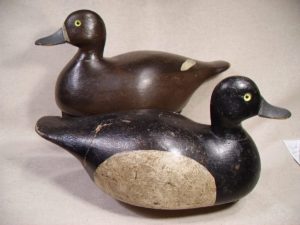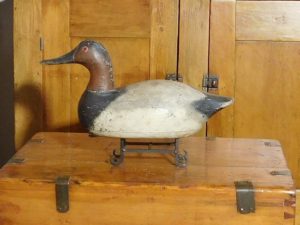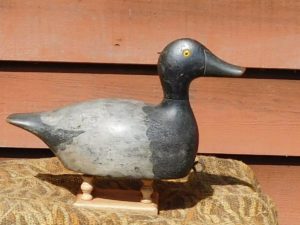A Decoy Corner Article
By Bruce Urben, WWA President
Images courtesy Wisconsin Sporting Collectibles
While in Oshkosh, WI and attending UW-Oshkosh in the 1970’s, my wife and I lived in a small, rented bungalow on Hazel Street, near the northern shore of Lake Winnebago. On a good day we could see Miller’s Bay on the Lake and were only a few blocks away from Menominee Park, also located on Lake Winnebago. I was fortunate to frequently accompany my next door neighbor for fishing and boating on Winnebago, as well as viewing the vast number of waterfowl calling lake Winnebago home… of course all of this was when I wasn’t studying!
In doing some research for an upcoming Illinois auction, I came across a decoy carved by an Oshkosh resident that had frequented (much earlier) some of the same areas in Oshkosh and on Lake Winnebago that I had. The decoy was well used but beautiful, with a high head, a bluebill drake carved in the traditional Winnebago style.
Here’s what I was able to find about this carver:
Edward Burgert was born in 1873 and according to his obituary, lived the majority of his life in the Oshkosh area. Burgert was employed as the Park Keeper at North Park in Oshkosh (now renamed Menominee Park). Ed was a passionate waterfowler from youth and hunted and fished on Lake Winnebago, and in particular in the Miller Bay area of northern Lake Winnebago.
Ed began carving later in life and was most active as a carver for about 15 years between 1925 and 1940. He carved his decoys from old telephone poles he obtained from the Oshkosh Public Works Deptartment. Ed did not have access to power tools in the 1920’s, so he used hand tools, including a hand axe to chop the bodies out of the telephone poles; draw knives, rasps, files and knives were used to give final shape to his decoys. It was noted that Ed carved some bill detail in his decoys, used glass eyes and his final oil painting had some resemblance to the classic “Mason Decoy Co.” swirls on the breast and tails. Most of his painting style was very simple, but done well to represent the species he was trying to duplicate.
My research tells me that Ed carved about 1,000 decoys in his lifetime, which included canvasback, bluebill and mallards. It’s been shared that Ed was assisted by a friend named George Voss. George actually worked for Ed at North Park (Menominee Park) and was his hunting companion on Winnebago. Some of Ed’s decoys were used on Miller’s Bay but many were sold to other Lake Winnebago waterfowl hunters. Written history tells us that he charged $1 for his decoys back in the day.
Ed passed away in 1956 at the age of 83.
Ed Burgert’s decoys were carved in the traditional Winnebago style: solid wood, flat bottom decoys with high heads and a smoothly arched tail.
As I write this article I have high hopes of adding a Ed Burgert Bluebill decoy to my Wisconsin collection, but won’t know until the auction closes after the new year. One thing I do know is that I won’t be paying near the going rate for Ed’s decoys back in the 1920’s, but I’m still hopeful to have his decoy joining my Wisconsin flock soon.
What I really wonder is how did Ed’s decoy, carved back in the 1920’s, make its way to a central Illinois auction house in late 2022, almost 100 years later… don’t you wish these decoys could talk?




